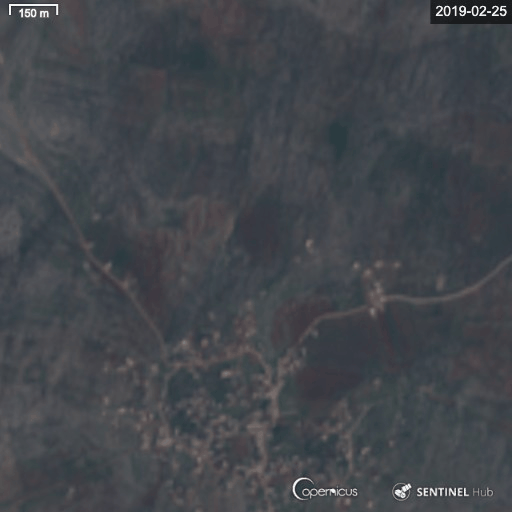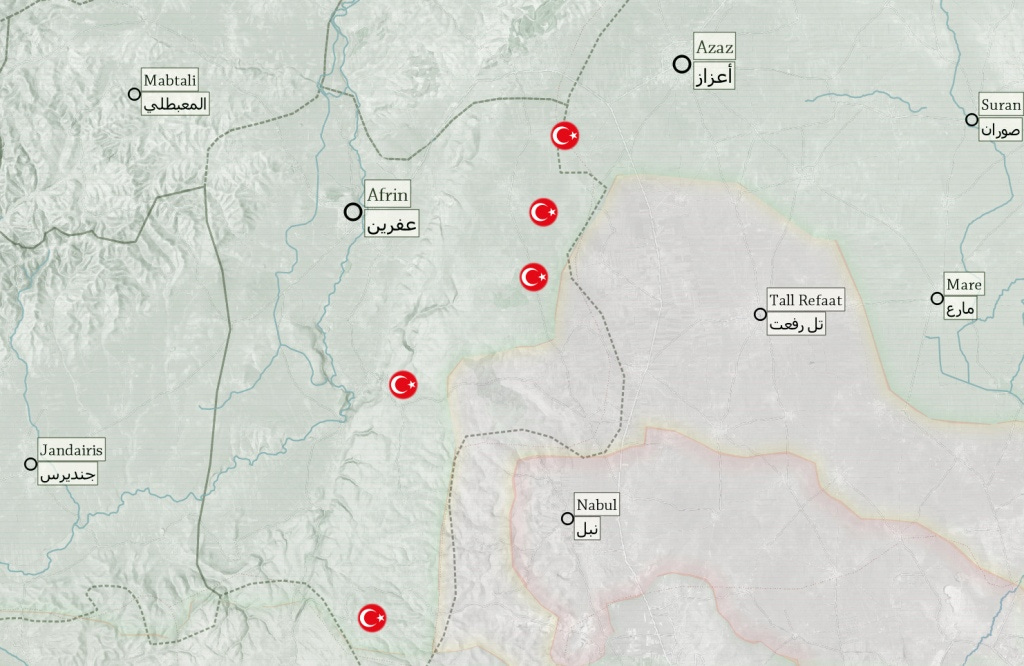The Militarization of Jebel Laylun: Turkish Fortifications in Eastern Afrin
originally published on Popularfront.co
In an article published on 16 April 2019, Rojava based Hawar News Agency reported on what it called a ‘separation wall’ being constructed along the eastern stretch of the Afrin district. This story was soon picked up by a number of local outlets and activist networks, sparking protests by native inhabitants of Afrin, who fled east during Turkey’s invasion of the area in early 2018. Accompanying these reports was footage filmed from nearby SDF controlled territory, highlighting newly assembled sections of concrete blast wall extending out from several villages in eastern Afrin. This stretch of hilly, rock-strewn terrain, known to locals as Jebel Laylun (Kurdish: Çiyayê Lêlûn), has become the frontline between the Turkish occupied region and the SDF controlled ‘Shahba canton,’ also containing nebulous regime and Russian presence.

Through available satellite imagery and other media, it has become clear over the course of the subsequent year that these stretches of wall will not constitute a contiguous border partition but are in fact parts of what is to be a ring of Turkish military bases surrounding Shahba. This development is at least in part a response to SDF-linked insurgent attacks in the area, highlighting the small scale conflict continuing in the wake of Turkey’s 2018 ‘Operation Olive Branch.’ This increasing fortification only raises further questions regarding the uncertain future of Turkey’s ongoing investment and military presence in the country as Syria enters its tenth year of civil war.

Rising an abrupt 350 meters above the Afrin river valley, the Jebel Laylun outcrop acts as a natural barrier between the region and the rest of Aleppo lying to the east. Archaeological remnants pave the landscape, documenting millennia of human existence on its hills.

Some of Jebel Laylun’s sites predate antiquity as exemplified by the discovery of a joint Japanese-Syrian excavation in 1993, uncovering the remains of a Neanderthal child in a wadi that spills out onto the Afrin plain. Countless Roman and Byzantine ruins dot the terrain; basilicas and villas abandoned over a millennium ago.
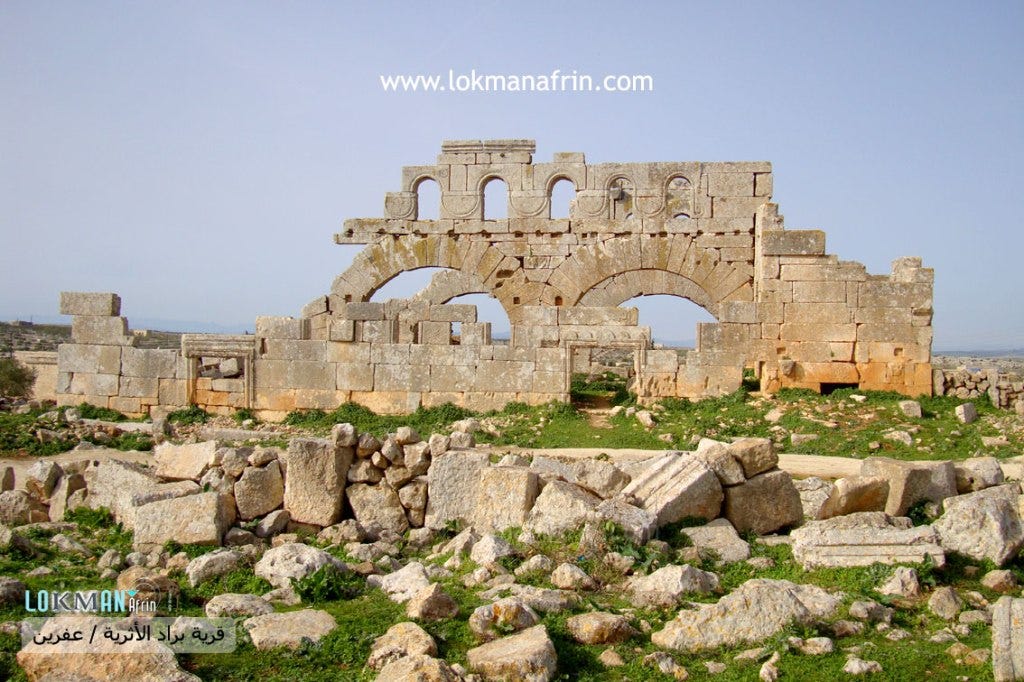
The grave of St. Maron, the fourth century Christian mystic and spiritual father of the present day Syriac Maronite Church, is located in the town of Barad (Kurdish: Beradê), drawing prominent pilgrims such as Lebanese President Michel Aoun in the years before the war. Believed to have arrived in the area from the east during the crusades, a significant portion of Afrin’s small Ezidi community has historically resided within Jebel Laylun. Tragically, effects of the war have drained Jebel Laylun of this population.

Initially many emigrated due to declining economic conditions as well as the threat of sectarian violence, epitomized by the genocide of their copractioners in Sinjar at the hands of the Islamic State. Others soon followed, taking flight from Turkey’s invasion of the area in 2018. Now this largely depopulated area is the frequent site of clashes and mutual shelling between the Turkish military and their Syrian proxies in the west and the SDF and likely front group Hêzên Rizgariya Efrînê (HRE) to the east.
When Turkish operations in Afrin ceased in late March 2018 only a handful of villages belonging to the region remained under SDF control. From this last foothold, insurgents affiliated with the YPG and other recently created militant groups began launching infiltration attempts and attacks targeting Turkish soldiers and allied Syrian opposition militants. Initially insurgent activity occurred at a frequent rate across the entirety of Afrin, likely carried out by cells left behind in the wake of Operation Olive Branch. However by the end of 2018 ambushes and clashes increasingly took place along the rocky front line of Jebel Laylun. This general shift eastward coincided with the creation of Hêzên Rizgariya Efrînê (‘Afrin Liberation Forces’) who have since become the preeminent insurgent outfit in Afrin. While HRE continue to carry out sporadic attacks deep within enemy territory, their actions typically originate from the Shahba region and include raids on makeshift frontline positions, sniping and the launching of anti-tank guided missiles (ATGMs) at an array of targets.

Afrin as a whole is controlled by a patchwork of often-conflicting armed groups (commonly referred to as the TFSA, or ‘Turkish Free Syrian Army’), civil and military police departments, as well as deployments of Turkish Jandarma and army units. The situation in Jebel Laylun comes across as significantly more straightforward, with only a handful of TFSA factions and the Turkish military present.

The towns and villages to the south, an area known as ‘Sherawa,’ appear to be under the control of Furqat al-Hamzah, an opposition group that enjoys close ties with Turkey. Since March of 2018, Furqat al-Hamzah has displayed its presence in the area on their official social media accounts, showing off their fighters undergoing training exercises and patrols, occasionally filming themselves firing mortars and rockets at nearby SDF controlled-territory, and announcing their ‘martyrs’ killed in clashes.



Faylaq al-Sham, another faction sharing historically close ties with Turkey, is also present to the far south of Jebel Laylun, in the vicinity of the al-Ghazawiyah (Kurdish: Xezîwê) crossing into Idlib. However, it’s unclear what role they play on the eastern frontlines. Further to the north, lies territory manned by two militant groups originally from the Damascus suburb of Eastern Ghouta; Faylaq al-Rahman and Jaysh al-Islam, both of whom largely arrived in northern Syria following evacuation deals reached with the regime in early 2018. Jaysh al-Islam has taken an active role on the front, entrenched in barricades in the village of Deir Mishmish and likely elsewhere nearby.


It’s unclear whether Faylaq al-Rahman is active in the same capacity as openly available information only shows them occupying an old military facility on the western slope of Jebel Laylun near the town of Qibare, which functions as a training and parade grounds. The northern reaches of Jebel Laylun feature the 3rd Legion, predominantly made of al-Jabhah al-Shamiyah (the ‘Levant Front’) and affiliated factions, who operate and defend the lucrative checkpoints along the road from Afrin to A‘zaz.


The frontline positions these factions man are a combination of dirt berms, impromptu shelters, and requisitioned houses. In some cases small crews of Turkish-backed fighters appear camped out in the open, lacking any sort of cover from guerrilla activity. In a recent attack carried out by HRE, a team of at least three insurgents ambushed unprotected opposition fighters from just behind the frontlines.


Juxtaposed with this haphazardness are well fortified positions currently being constructed across Jebel Laylun by Turkey.
Most of the footage of this ongoing Turkish construction has focused on the village of Jalbul (Kurdish: Cilbirê). Jalbul’s prominence in these reports likely stems from it being one of the first sites where such activity began, as well as its proximity to SDF territory. Located under three kilometers from the nearest town in the Shahba region, separated only by a plain of fields and orchards, it’s quite accessible to local camera crews.

Initial video of activity in Jalbul from mid-April showed excavators undertaking the demolition of approximately two dozen homes and adjacent buildings in the center of the village. According to some sources, this included Jalbul’s school as well as a local meeting hall.

Actually predating the first local media reports on Jalbul by a couple days, a video published by HRE on 6 April 2019 showed an ATGM crew targeting one of the excavators being used in the demolition.
Subsequent footage of the demolition site shows that debris was removed in the following weeks and months, leaving a leveled rectangular area soon surrounded by blast walls.

One such video where this development is visible is that of a HRE attack that took place in May 2019 in which the insurgents used a weaponized commercial drone to drop munitions on targets next to the Jalbul construction site.

Other than the demolition that occurred, these reports also highlighted a kilometer long concrete wall assembled along a north-south road running through the town.

Vehicles taking part in the installment of this wall were targeted by HRE ATGM fire on 6 April 2019 as well.
Following this road until a branch turns west towards the rest of Afrin, the wall’s likely purpose is to shield vehicles from ATGM fire as they enter and exit Jalbul.

While initial fears led many to assume this wall was to extend the length of the Afrin-Shahba border, further segments do not appear to have been added since early summer 2019.
Since May of 2019 several structures have been erected within this walled-off area. This development can be observed through satellite imagery, though unfortunately only low resolution images are available at the moment.
Jalbul base
With the proliferation of Turkish bases in Idlib and surrounding areas, a number of images of similar positions at advanced stages of construction are now available. These allow one to visualize how the position at Jalbul and others in the area are likely to develop.



Occurring simultaneously with the demolition taking place inside Jalbul, construction of another wall began outside the town of Kimar (Kîmarê). While less footage of this structure has been published than that in Jalbul, one can observe it grow through media published over the next several months.



Using satellite imagery, one is able to observe that the orchard located behind the wall was leveled, giving way to a cordoned-off rectangular area similar to that in Jalbul.
Kimar base
As was the case in Jalbul, HRE targeted construction vehicles working on the Kimar site with ATGM fire in early May 2019.
Videos of two additional HRE attacks, occurring in August and September of 2019, show that more blast walls were erected on the town's southern outskirts. This second site includes a building with a large courtyard which, judging by its layout, is likely a school.


Satellite images taken in the months following the capture of Kimar in late March 2018 repeatedly show a number of military vehicles parked on this property, indicating it’s part of this now fortified area. While it’s clear these several buildings now serve a military function, whether this position houses Turkish soldiers or Syrian proxies is unknown. However, two Turkish soldiers were killed within the vicinity of Kimar during clashes in December 2018 and in June 2019, while another set of clashes in August 2019 led to Turkey helivacing their wounded out of Kimar, as captured on camera by locals.
AA video published by the Syrian Observatory for Human Rights (SOHR) on 19 April 2019 showing the sites in Jalbul and Kimar also included footage of another supposed wall segment in the town of Maryamin (Kurdish: Mêremînê), about five kilometers north of Jalbul. This low quality recording, taken like the others from SDF territory to the east, shows what appears to be a wall running along a portion of the main road in the middle of the town.

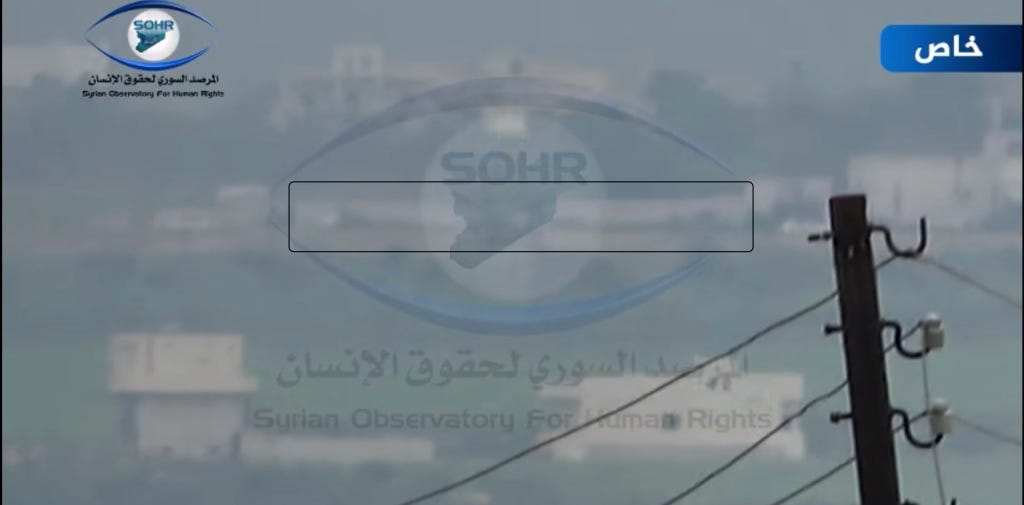
Through comparing this footage with other videos shot of the same location this structure does not appear to be new and does not resemble the recently assembled blast walls in other parts of Jebel Laylun. The same wall appears in a HRE ATGM video published in June 2019 and shot from a similar location. Here it does not seem to be shielding the road from the east, but instead looks to run behind a building to the west.
A video filmed by an opposition aligned media outfit on the day the town was captured from the SDF in March 2018 features a reporter standing on this same road, in front of the same building. A white wall behind the building’s parking lot briefly becomes visible, likely the same visible in the SOHR and HRE videos taken of this location from a distance.


Given the poor quality of the SOHR footage it is hard to be completely certain, but it would appear this wall predates the Turkish invasion and subsequent construction in the area.
Despite this, two positions (36.534195, 36.959858 and 36.516889, 36.963468) have emerged in this time period on the eastern outskirts of Maryamin and the town of Inab (Kurdish: Enabkê) immediately to its south. Soon after the capture of these towns in March 2018, military vehicles began to appear in these two frontline locations located approximately two kilometers apart from each other. While both feature dirt berms and appear to have been in continuous usage since they were established, the southern position has undergone similar construction activity as the sites in Jalbul and Kimar. High quality satellite imagery from summer of 2019 showed cement walls erected to the east and south, with accompanying efforts to level the ground behind the wall. Given the current lack of publicly available high quality satellite imagery, only the latter is visible at present.
Inab base
Two other positions resembling those in Jalbul, Kimar, and Inab appear to be under construction in other locations along the Jebel Laylun frontlines. To the southeastern most reaches of Afrin, a rectangular orchard plot on the outskirts of the town of Basoufan (Kurdish: Basûfanê) was requisitioned in the summer of 2019. Photos and video published in July and August show the trees of the orchard having been cut down, and the ground levelled. Through lower quality satellite imagery taken later in the year, walls are visible along the perimeter.
Basoufan base
The last of these frontline fortifications sits just past the village of Malkiyah, the northwestern most settlement under SDF control. Located just six kilometers west of A‘zaz, an initial military position made of earthen berms was dug here in the summer of 2018. Since then, significant construction has occurred, resulting in a familiar rectangular shape.
Malkiyah base
Since spring of 2019, Turkish press has reported as many as five soldiers killed during their deployment to Syria at a ‘Malkiyah base,’ presumably this recently expanded position under two kilometers from the village of the same name. Further away from the frontlines, similar construction sites are visible using satellite imagery in other parts of Afrin including locations near the towns of Kafr Jannah, Jandaris, Iskan, and Darwishah, each sitting at an elevated position.
It’s unclear to what extent these fortifications have had in stemming insurgent attacks from Shahba-based HRE so far. While attacks deep within Afrin have largely dropped off from their high point in the summer and fall of 2018, this trend preceded this recent construction and was likely caused by the gradual exhaustion of YPG cells left behind in Afrin in the wake of Olive Branch. Whether in the form of ATGM launches or raids on TFSA positions, HRE’s attacks have continued at a rate similar to early 2019.
HRE activity shows that the Jebel Laylun frontlines remain permeable despite increasing fortification. Footage published on 21 October 2019 shows insurgents on the western edge of Jebel Laylun firing ATGMs from these heights, targeting vehicles and positions in the Afrin valley below. Their position is located inside Turkish-controlled territory, under two kilometers northwest of the Kimar construction site.
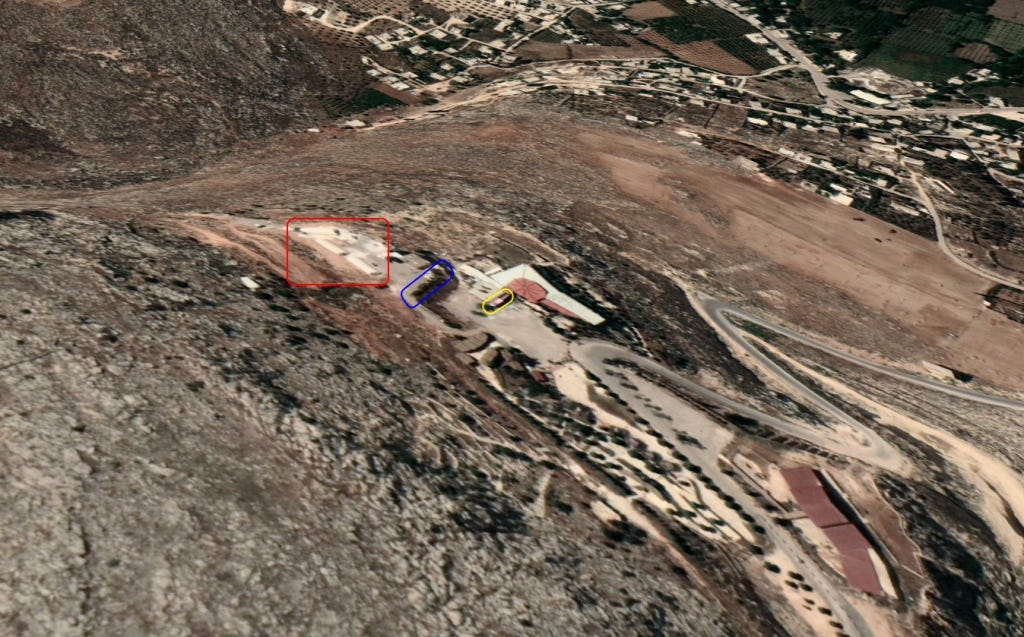
This construction in Jebel Laylun only further extends and entrenches the Turkish military footprint within Afrin at large. Despite continued guerilla activity, it remains highly unlikely that the SDF or the hundreds of thousands of displaced natives of Afrin, including the Ezidi of Jebel Laylun, will return to the region at any point soon. While the fate of Idlib remains up in the air due to the conflicting interests and strategies of Russia, Turkey, and the regime, for the time being and with Russian acquiescence, Afrin is firmly under Turkish control.
Note: HRE footage referenced in this article can be found on the group’s official Telegram channel @HRE_official, the channel @Servanenefrine, as well as HRE’s Facebook page.








